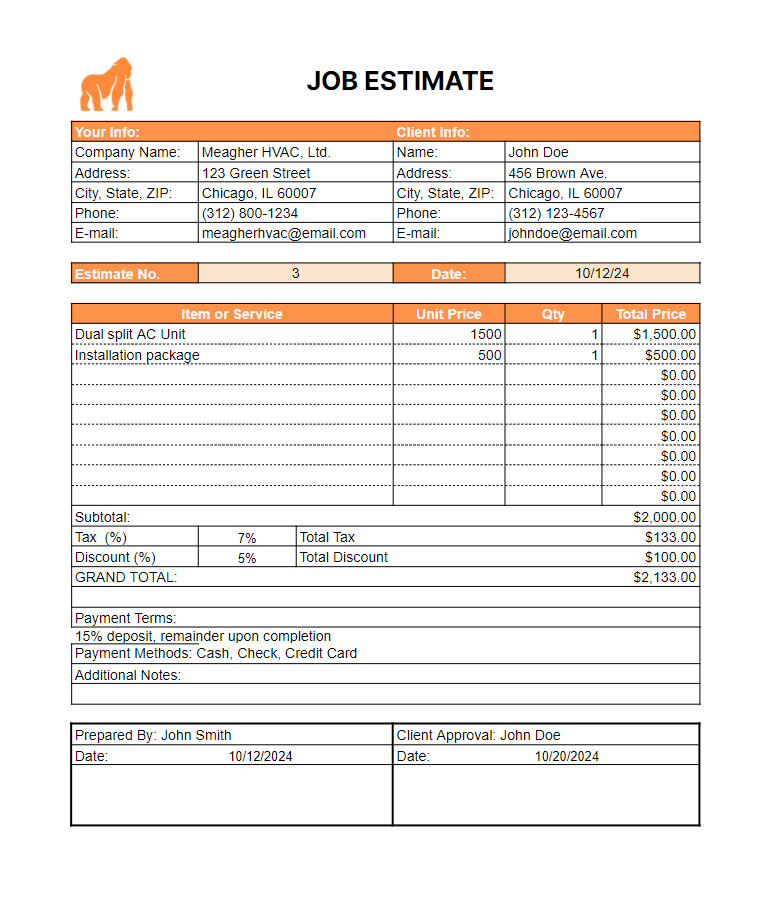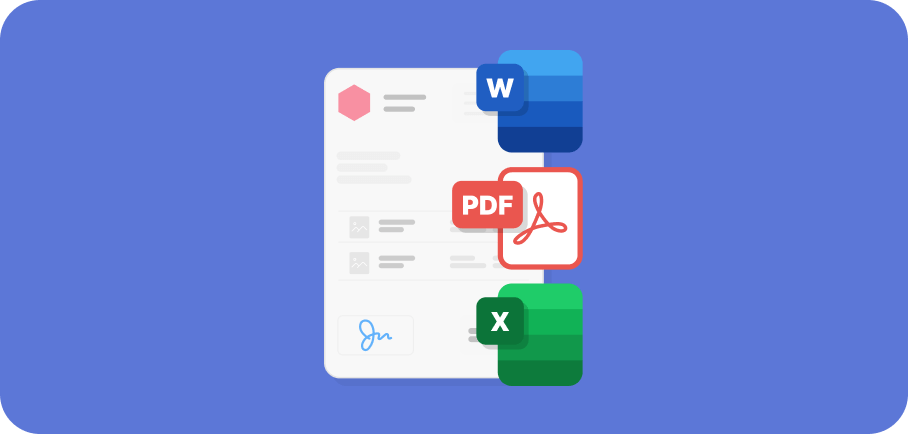Creating professional job estimates and quotes is one of the easiest ways to win more and better jobs. Estimates help set clear expectations and ensure both parties agree on the scope and cost of the work. Customers use estimates to compare the total cost of your services and your expected timelines with those of competitors. They’ll also help you identify your most profitable projects, so you can focus your efforts there.
This guide covers the differences between quotes and estimates, the key elements of an estimate, and how to write a professional looking job estimate (we’ve included a sample template below). Once you come to an agreement with your client, you can use invoicing software to convert your estimate into an invoice after finishing the job.
Table of Contents
Key Takeaways
- Include company and customer info, project description, itemized costs, taxes, total estimate, and terms.
- Understand the project’s scope, itemize services and materials, set a clear timeframe, and proofread.
- Research competitors, use customizable templates, and consider professional help for polished estimates.
- Software provides template personalization and simplifies converting estimates into invoices.
Are an estimate and a quote the same thing?
Many people, including some seasoned business owners, use estimate and quote interchangeably, but there some important differences:
- An estimate should be professionl and needs to give an accurate outline of your costs, materials, and the expected timeline of the project, but it is not legally binding.
- A quote is legally binding after accepted and should include greater detail on the breakdown of costs, materials, and the timelines for delivery. Upon delivery, deviances from the quote can be contested.
Remember, an estimate is, in essence, an educated guess at the overall cost of a project. You may not yet have all the details to provide a full quote. Many times an estimate is a jumping off point for negotiations and will eventually turn into a quote. Providing a competitive estimate shows clients you have the necessary experience to reasonably describe costs and materials before you have the full details of the job.
What to include in a job estimate
The information included in an estimate varies slightly based on your services, industry, and personal preferences. Here are a few of the basics you should consider including:
- Company Contact Info
- Customer Information
- Estimate Number
- Date of Submission
- Project Description
- Itemized Costs and Material Costs
- Taxes
- Grand Total
- Terms and Conditions
- Thank You Note/Company Message
Steps to Create a Professional Job Estimate
Creating a professional estimate requires gathering detailed information from the client and accurately reflecting it in your proposal. While an estimate is not a contract, the more you treat it like one the more accurate and focused the end result will be. Follow these steps to ensure a comprehensive and clear job estimate:
- Client Contact Information: Obtain the client’s full name, company name (where applicable), address, phone number, and email. This information should be clearly displayed at the top of the estimate to ensure proper communication.
- Project Scope and Description: Discuss the project details with the client to understand their specific needs and expectations. Include a detailed description of the project in the estimate, outlining the tasks to be performed, goals, and deliverables.
- Timeline and Deadlines: Ask the client about their desired timeline and any critical deadlines. Highlight these in the estimate by providing an estimated start and completion date, along with any key milestones.
- Budget and Cost Constraints: Understand the client’s budget and any cost limitations they may have. Include a breakdown of all costs in the estimate, such as labor, materials, and any additional fees, ensuring everything aligns with the client’s financial expectations. Be sure to price out any subcontractors for tasks or activities you will not be able to handle yourself.
- Special Requirements or Preferences: Inquire about any specific requirements, preferences, or constraints the client may have. This could include preferred materials, quality standards, or working conditions. Make sure to highlight these details in the estimate.
- Terms and Conditions: Clarify the terms and conditions with the client, including deposits, payment terms, warranty information, and any other relevant policies. Ensure that these are clearly stated in the estimate to avoid any misunderstandings.
- Client Approval and Next Steps: Outline the process for client approval and the next steps once the estimate is accepted. Include a section for the client’s signature and date to formalize the agreement.
By thoroughly gathering and including this information in your estimate, you can create a professional, detailed, and accurate document that meets the client’s needs and expectations.
Pro Tip
Most clients won’t have all the details, or they may only know what they want something to ‘look like’ when finished. Making suggestions demonstrates your experience. If you’re a contractor, visit the job site to get more info.
Use Software to Ensure Professional Estimates
The use of estimation, invoicing, and business management software like STEL Order offers numerous benefits and streamlines the process of creating professional job estimates:
- Accuracy: Reduce human errors by automating calculations.
- Efficiency: Save time by leveraging past estimates and cataloged materials and services.
- Consistency: Ensure uniformity across all estimates, enhancing professionalism.
- Customization: Easily tailor estimates to meet specific client needs and include company branding.
- Tracking: Keep a detailed record of all your estimates and quickly see how many jobs you win to detect trends.
Together, this simplifies the process and reduces administrative burden throughout the sales cycle:
- Templates: Take advantage of pre-designed templates that can be easily customized.
- Integration: Sync with other business tools like accounting and inventory management for seamless data management.
- Real-time Updates: Reflect changes instantly, ensuring up-to-date information.
- Cost Tracking: Track income and expenses, adjusting estimates and invoices accordingly.
By leveraging estimation software, businesses can efficiently create accurate, professional, and customized estimates. Click here to try STEL Order’s estimate and invoicing software for free, and discover how it will streamline your process.
Example Job Estimate Template
Below we have provided an example of a Job Estimate template that contains all the basic information you should include on your estimates. You can download the template for free and fill out manually, or sign up for a free trial with STEL Order and create estimates and invoices in a snap from anywhere.


Conclusion
Drafting clear and competitive estimates is an essential part of winning more jobs and helps your customers budget for costs. Well-written estimates include the scope of the project, a reasonable estimate of costs and materials as well as the expected timeline for execution.
The most important step in writing a quality estimate is to get as much information as possible from your potential client. Depending on your experience, checking out competitiors’ rates may help to give you a sense of where your pricing is in the market. When you’re ready to streamline your business with an efficient and effective system to create estimates and convert them into invoices, estimating software like STEL Order helps you streamline this process online.
FAQs
What are the 3 main types of job estimates?
- The primary types of job estimates are preliminary estimates, detailed estimates, and bid estimates. Preliminary estimates provide a rough cost idea, detailed estimates include specific cost breakdowns, and bid estimates are used to win projects by competing with other estimates.
How do job estimates differ from quotes and invoices?
- Job estimates provide an initial cost projection and are not legally binding. Quotes give a detailed breakdown of costs and become a legal contract once accepted. Invoices are bills for services rendered, detailing final costs and payment terms.
Why is it important to include a detailed breakdown in a job estimate?
- A detailed breakdown helps clients understand the cost components, builds trust, ensures transparency, and minimizes the risk of disputes. It shows professionalism and helps manage client expectations.
How can you ensure your job estimate is competitive and accurate?
- To ensure competitiveness and accuracy, research industry standards, analyze competitor pricing, use historical data, consult with suppliers, and regularly update your cost calculations. Also, consider contingencies and avoid underestimating to maintain profitability.
